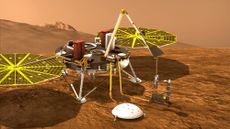Celestial events to watch in 2024
Meteor showers, eclipses and more are coming to the skies


The cosmos are always moving, changing and making way for awe-inspiring astronomical phenomena. These are the best, most exciting events to watch for in the coming weeks and months.
Perseid meteor shower (July 17 - Aug. 24, 2024)
The Perseid meteor shower is one of the most vibrant of the year. While it lasts approximately a month, the shower is expected to peak between Aug. 11 and Aug. 12. At its peak, you can expect to see 60 to 100 meteors in an hour from a dark place, making the Perseid shower "widely sought after by astronomers and stargazers," TimeandDate said.
The Perseids are caused by debris from the comet 109P/Swift-Tuttle. The meteors "frequently leave long 'wakes' of light and color behind them as they streak through Earth's atmosphere," said NASA. At the peak of the shower, "the moon will be about 50 percent illuminated," the Smithsonian said. "It will set at midnight, so optimal viewing conditions are early in the morning until dawn."
Subscribe to The Week
Escape your echo chamber. Get the facts behind the news, plus analysis from multiple perspectives.

Sign up for The Week's Free Newsletters
From our morning news briefing to a weekly Good News Newsletter, get the best of The Week delivered directly to your inbox.
From our morning news briefing to a weekly Good News Newsletter, get the best of The Week delivered directly to your inbox.
Partial lunar eclipse (Sept. 18, 2024)
On the night of Sept. 17 into Sept. 18, a portion of the moon will pass through the Earth's shadow, resulting in a partial lunar eclipse. The phenomenon will be visible throughout North and South America, Europe and Africa. Unlike a solar eclipse, a lunar eclipse can be viewed without protective eyewear.
"Because the moon orbits the Earth at an angle of about five degrees — rather than along a flat plane — the shadow is often cast above or below the moon's orbit," said the Smithsonian. However, "about twice a year during the full moon, the angle is just right for an eclipse."
Annular solar eclipse (Oct. 2, 2024)
An annular or "ring of fire" solar eclipse will be visible on Oct. 2. In an annular eclipse, "the moon is slightly farther from Earth. So, even when the disks align from our perspective, the moon's shadow doesn't completely block out the sun's light," said Space.com. "Instead, a ring of sunlight is visible around the moon." The true annular eclipse will be visible from southern Chile and southern Argentina, while a partial solar eclipse, where the moon covers only part of the sun, will be visible across the Pacific Ocean and South America.
It is never safe to look directly at an annular eclipse and eclipse glasses are necessary. This annular eclipse will cover 93% of the sun and last approximately seven and a half minutes, which is longer than usual. The best location to see the eclipse is Rapa Nui or Easter Island. "Remarkably, it will be the second time a central solar eclipse has been visible from this tiny Pacific island in recent decades," said Space.com.
Draconid meteor shower (Oct. 6 - 10, 2024)
The Draconid meteor shower is going to occur between Oct. 6 and 10 peaking on Oct. 8. "Unlike many meteor showers, more Draconids are likely to fly in the evening hours than in the morning hours after midnight," said Earthsky.com. "This shower is usually a sleeper, producing only a handful of languid meteors per hour in most years," but "in rare instances, fiery Draco has been known to spew forth many hundreds of meteors in a single hour."
The meteorites in the shower come from the comet 21P/Giacobini-Zinner. The best way to see the shower is to "go to the darkest possible location, lean back and relax," said Space.com. "You don't need any equipment like telescopes or binoculars; the secret is to take in as much sky as possible and allow about 30 minutes for your eyes to adjust to the dark."
Comet Tsuchinshan-ATLAS (Oct. 12 - 19, 2024)
The comet Tsuchinshan-ATLAS will pass near Earth in fall of 2024. It is also expected to be visible to the naked eye. The comet will be approximately 44 million miles away from Earth at its closest point, and has the potential to be bright and vibrant. "Pretty much right away, it started a buzz in the comet community, because predictions were putting it all over the place in terms of how bright it could get," Ariel Graykowski, a planetary astronomer at the SETI Institute in Mountain View, California, said to Scientific American.
Comets are notoriously unpredictable, being that they are "dusty, icy relics of planetary formation that were hurled to the solar system's outskirts eons ago," said Scientific American. Like leftovers at the back of your freezer, "they spend most of their time inert and unnoticed in the dark." As this event gets closer, scientists can better predict its visibility; however, many already forecast a "fantastic celestial spectacle."
Orionid meteor shower (Sept. 26 - Nov. 22, 2024)
The Orionid meteor shower is a staple of the fall. This year it will peak between Oct. 20 and Oct. 21 with a rate of approximately 20 meteors per hour. "Sometimes the Orionid meteor shower produces spectacular displays of up to 80 meteors an hour, but in recent years it has produced more modest displays of about 20 or 30 visible meteors per hour," said Space.com. The Orionids are also produced from Halley's comet like the Eta Aquarids.
Visibility this year may be reduced because the "moon will be 79% illuminated at the time of the peak." Space.com added. However, they should still be visible to both the northern and southern hemispheres. To have the best view, go to as dark a location as possible between midnight and dawn and let your eyes adjust.
Leonid meteor shower (Nov. 3 - Dec. 2, 2024)
The Leonid meteor shower is set to take place throughout the month of November, peaking on November 16. The shower occurs when "Earth passes through the debris left behind by comet 55P/Tempel-Tuttle during its highly elliptical orbit around the sun every 33 years," said Space.com. Leonid meteors can move quickly at approximately 44 miles per hour across the sky.
Leonids are known for their "fireballs and Earth-grazer meteors," said NASA. "Fireballs are larger explosions of light and color that can persist longer than an average meteor streak." In order to get the best viewing experience, experts recommend going to a very dark location and allowing your eyes to adjust for 30 minutes.
Create an account with the same email registered to your subscription to unlock access.
Sign up for Today's Best Articles in your inbox
A free daily email with the biggest news stories of the day – and the best features from TheWeek.com
Devika Rao has worked as a staff writer at The Week since 2022, covering science, the environment, climate and business. She previously worked as a policy associate for a nonprofit organization advocating for environmental action from a business perspective.
-
 The week's best photos
The week's best photosA helping hand, a rare dolphin and more
By Anahi Valenzuela, The Week US Published
-
 Today's political cartoons - August 30, 2024
Today's political cartoons - August 30, 2024Cartoons Friday's cartoons - seasoned vets, football season, and more
By The Week US Published
-
 'Harris gains slim lead'
'Harris gains slim lead'Today's Newspapers A roundup of the headlines from the US front pages
By The Week Staff Published
-
 Is billionaire's 'risky' space flight about research or tourism?
Is billionaire's 'risky' space flight about research or tourism?In the Spotlight Jared Isaacman takes an all-private crew to space
By Joel Mathis, The Week US Published
-
 The complex continent conundrum
The complex continent conundrumThe explainer Experts cannot agree on how many continents there are
By Devika Rao, The Week US Published
-
 Nasa's astronauts: stranded in space
Nasa's astronauts: stranded in spaceIn the Spotlight Sunita Williams and Butch Wilmore's eight-day trip to the ISS has now stretched into weeks amid concerns over their Starliner spacecraft
By The Week UK Published
-
 Why water on Mars is so significant
Why water on Mars is so significantThe Explainer Enough water has been found to cover the surface of the Red Planet – but there's a catch
By Chas Newkey-Burden, The Week UK Published
-
 What is NASA working on?
What is NASA working on?In Depth A running list of the space agency's most exciting developments
By Devika Rao, The Week US Published
-
 Liquid water detected on Mars raises hopes of life
Liquid water detected on Mars raises hopes of lifeSpeed Read A new study suggests huge amounts of water could be trapped beneath the surface of Mars
By Peter Weber, The Week US Published
-
 Nasa's 'strangest find': pure sulphur on Mars
Nasa's 'strangest find': pure sulphur on MarsUnder the Radar Curiosity rover discovers elemental sulphur rocks, adding to 'growing evidence' of life-sustaining elements on Red Planet
By Harriet Marsden, The Week UK Published
-
 10 recent scientific breakthroughs
10 recent scientific breakthroughsIn Depth From cell reparation to reef restoration
By Devika Rao, The Week US Published